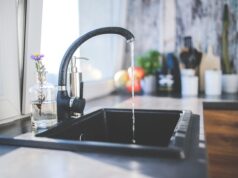Contents
Kitchen Sink Plumbing Explained: Demystifying the Dual Drain Pipe System
When it comes to kitchen sink plumbing, understanding the dual drain pipe system is crucial. This article aims to demystify the concept and provide a clearer understanding of how it works.
The dual drain pipe system in a kitchen sink refers to the setup where there are two separate pipes for the sink’s drainage system. One pipe is connected to the sink’s main basin, while the other is connected to the smaller secondary basin (garbage disposal) or the dishwasher.
This system offers several advantages. For instance, it allows for multiple sources of water to be drained simultaneously without causing any clogs or backups. The primary basin can be used for regular dishwashing or handwashing, while the secondary basin can be used for disposing of food waste or cleaning dishes.
To ensure proper functioning of the dual drain pipe system, it is essential to maintain and clean the pipes regularly. Blockages or debris buildup can lead to slow drainage or complete blockage, requiring professional intervention.
By understanding the design and purpose of the dual drain pipe system, homeowners can make informed decisions regarding their kitchen sink plumbing needs. It is always recommended to consult with a professional plumber for any installation or repair requirements.
Kitchen Sink Plumbing Explained: Demystifying the Dual Drain Pipe System
Understanding the Dual Drain Pipe System
The plumbing system for a kitchen sink often involves a dual drain pipe setup. This system consists of two separate drains known as the “strainer drain” and the “disposal drain.” Understanding how these components work together is essential for any homeowner or aspiring plumber.
1. Strainer Drain
The strainer drain is the primary drain of a kitchen sink. It is typically fitted with a removable strainer that captures solid debris while allowing water to pass through. The strainer drain provides an initial filtration process, preventing larger food particles or foreign objects from clogging the plumbing system.
2. Disposal Drain
The disposal drain, as the name suggests, is specifically designed to connect to a garbage disposal unit. It is located on the other half of the sink and usually has a rubber gasket or flange to create a watertight connection with the disposal unit. Its purpose is to facilitate the disposal of food waste.
How the Dual Drain Pipe System Works
The dual drain pipe system allows for efficient management of wastewater and food waste in the kitchen sink. Here’s a breakdown of how it works:
1. When you use the strainer drain, water and small food particles flow through the strainer and into the drainpipe.
2. The collected wastewater is then channeled to the main plumbing system, which leads to the sewer line or septic tank.
3. If you have a garbage disposal unit, any food waste that enters the disposal drain is ground down into smaller pieces by the disposal blades.
4. The ground-up food waste is then flushed down the disposal drain and mixed with the wastewater from the strainer drain.
5. Finally, the combined wastewater and food waste flow into the main plumbing system for proper disposal or treatment.
Troubleshooting the Dual Drain Pipe System
While the dual drain pipe system is generally reliable, a few common issues may arise. Here are a couple of troubleshooting tips:
1. Clogs: If you experience slow drainage or complete blockage, it may be due to a clog in either the strainer or disposal drain. Check for any obstructions and use a plunger or a plumbing snake to unclog the pipes.
2. Leaks: Leaks can occur at the connections between the sink, strainer drain, and disposal drain. Make sure all the connections are tightened properly and, if necessary, consider using plumber’s putty or Teflon tape to create a better seal.
Remember, it’s always essential to prioritize safety when working on any plumbing system. If you’re unsure about any repairs or encounter major issues, it’s best to consult a professional plumber to avoid further damage or potential health hazards.
Conclusion
The dual drain pipe system in a kitchen sink plays an integral role in managing wastewater and food waste. Understanding how the system works and conducting regular maintenance can help prevent clogs and leaks, ensuring your plumbing functions smoothly. Remember to take necessary precautions and seek professional assistance if needed.
For more information, you can visit www.plumbing.com or www.homeplumbingguide.com to learn more about kitchen sink plumbing and related topics.
Frequently Asked Questions
What is a dual drain pipe system in kitchen sink plumbing?
A dual drain pipe system in kitchen sink plumbing refers to the setup where two separate drain pipes are installed under the kitchen sink. One drain pipe is usually connected to the sink’s main drain, while the other is connected to a secondary drain such as a garbage disposal unit.
Why is a dual drain pipe system used?
A dual drain pipe system is used to separate the regular wastewater from the kitchen sink (such as dirty water from washing dishes) from the waste processed through a garbage disposal unit. This system allows for effective disposal of kitchen waste without clogging the main drain and ensures smooth functioning of the plumbing system.
How does the dual drain pipe system work?
The dual drain pipe system works by routing the water and waste from the sink into two separate drain pipes. The primary drain pipe collects water and waste from regular kitchen activities and directs it towards the main drain. The secondary drain pipe, typically connected to the garbage disposal, handles the waste processed through the disposal unit and redirects it towards the main drain as well.
Can I install a dual drain pipe system myself?
Installing a dual drain pipe system may require advanced plumbing knowledge and skills. It is recommended to hire a professional plumber to ensure the system is setup correctly and functions properly.
What are the common problems with a dual drain pipe system?
Common problems with a dual drain pipe system include clogs or blockages in either the primary or secondary drain pipes, leaks at the connection points, or issues with the garbage disposal unit itself. Regular maintenance and proper usage can help prevent these problems.
Understanding the Two Drain Pipes under the Kitchen Sink
The Purpose of Having Two Drain Pipes
In most kitchen sinks, you may have noticed that there are two separate drain pipes. These pipes serve different purposes and are crucial components of the sink’s drainage system.
The Primary Drain Pipe (P-Trap)
The first and larger of the two pipes is called the “P-Trap.” It is shaped like the letter “P,” hence the name. The P-Trap is responsible for preventing foul odors, harmful sewer gases, and pests from entering your kitchen through the sink drain.
This pipe plays a vital role in maintaining a healthy and odor-free kitchen environment. By creating a water seal, the P-Trap prevents gases from the sewer system from floating back up into your home.
The Secondary Drain Pipe (Drain Pipe Extension)
The smaller, slimmer pipe connected to the P-Trap is known as the “Drain Pipe Extension.” Its purpose is to allow wastewater from the sink to flow down into the main drainage system.
While the P-Trap acts as a barrier to gases, the Drain Pipe Extension facilitates the smooth discharge of dirty water. It connects the sink drain to the main sewage line in your house, ensuring proper drainage and preventing clogs.
By having both the P-Trap and Drain Pipe Extension, your kitchen sink benefits from an efficient drainage system and protection against unwanted odors and gases.
Conclusion
The presence of two drain pipes under the kitchen sink, namely the P-Trap and the Drain Pipe Extension, serves distinct purposes. While the P-Trap functions as a barrier against odors and gases, the Drain Pipe Extension ensures proper wastewater discharge to prevent clogs. Together, they contribute to a well-functioning sink drainage system.
For more information about sink drainage and plumbing systems in general, you can visit the Wikipedia page on drain-waste-vent systems.
Kitchen Sink Plumbing Explained: Demystifying the Dual Drain Pipe System
Overview:
- Understanding the dual drain pipe system in kitchen sink plumbing
- Explaining the purpose of each drain pipe
- Clearing common misconceptions about the dual drain pipe system
Understanding the Dual Drain Pipe System:
- Two drain pipes underneath the kitchen sink
- One drain pipe for the disposal unit
- Second drain pipe for the main sink
Purpose of Each Drain Pipe:
- Disposal drain pipe carries waste from the garbage disposal unit
- Main sink drain pipe carries waste from the sink
- Preventing clogs and maintaining proper drainage
Clearing Common Misconceptions:
- Dispelling the myth that the dual drain pipe system is unnecessary
- Explaining why separate pipes are essential for effective waste disposal
- Highlighting the importance of regular maintenance to avoid plumbing issues


































